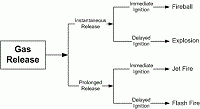Formal Safety Analysis / Assessments

Price
Add to Cart
Formal Safety Assessments
Once the facility description is finalized and guidance for allowable risk is provided, a Formal Safety Assessment (FSA) can commence. (A Formal Safety Assessment is part of the development of a Safety Case.)
An FSA requires the identification and evaluation of hazards over the life of the project from the initial feasibility study through the concept design stage, to construction and commissioning, then to operation, decommissioning and abandonment of the facility. The FSA provides the technical basis for demonstrating that a design or operation is safe. The purpose of an FSA is to identify major hazards, assess the associated risks, and to show that those risks have been reduced to an acceptable level over the life of the installation. (Hence the FSA needs to provide criteria for acceptable risk.)
The FSA should thoroughly analyze potential Major Accident Events that could lead to fatalities or major equipment and production loss. The analysis should show what safeguards have been put in place, and how the facility would respond to a major incident.
Analyses and studies that are frequently carried out during an FSA include the following:
- Assumptions Register
- Hazards Register
- Flare and Radiation Analyses
- Escape, Evacuation and Rescue Analysis (EERA)
- Temporary Refuge Analysis
- Human Factors Engineering
- Thermal Plume Analysis
- Reliability, Maintainability and Risk
- Quantitative Risk Assessment (QRA)
- Facility Layout and Equipment Arrangement
- Material Handling Risk Assessment / Dropped Objects
- Transportation
- Fire and Gas Detection
- Gas Dispersion Analysis
- Fire and Explosion Analysis
- Escape, Evacuation and Rescue
- Non-Hydrocarbon Chemicals
- Greenhouse Gas Emissions
- Noise and Vibration
- Human Factors Engineering
- Reliability, Availability and Maintainability (RAM)
The International Maritime Organization (IMO, 2002) lists the five stages in the development of a formal safety assessments (FSA): Identification of hazards (a list of all relevant accident scenarios with potential causes and outcomes), assessment of risks, identification of control options, cost-benefit assessment for each risk control option, and recommendations for decision making. Further guidance is provided in ISO 31010: Risk Management/Risk Assessment techniques.
An FSA should show that all pertinent regulations and standards have been addressed. It demonstrates that all reasonably practicable steps have been taken to ensure the safety of employees in the event of an emergency and during their transit to a place of safety. It should be demonstrated in particular that the integrity of the temporary refuge (TR), escape, and evacuation routes are maintained in the case of a major accident event, and that all reasonably practicable steps have been taken to ensure the safety of employees in the event of an emergency and during transit to a place of safety.

